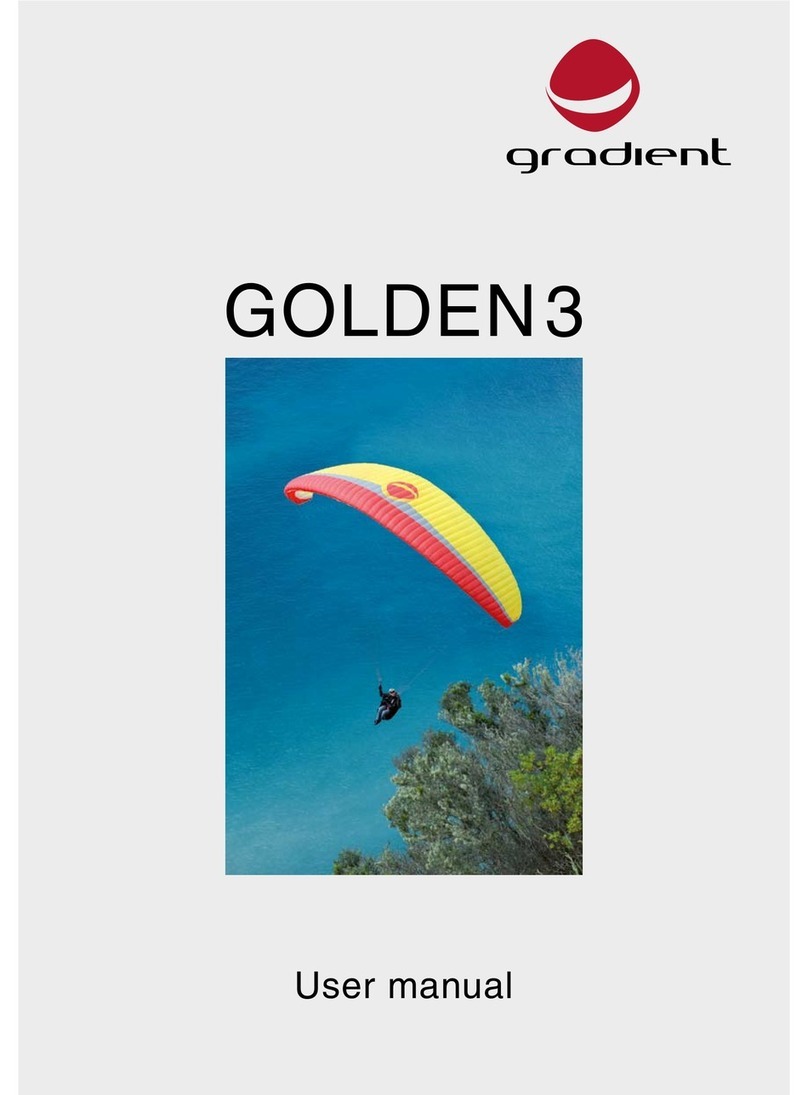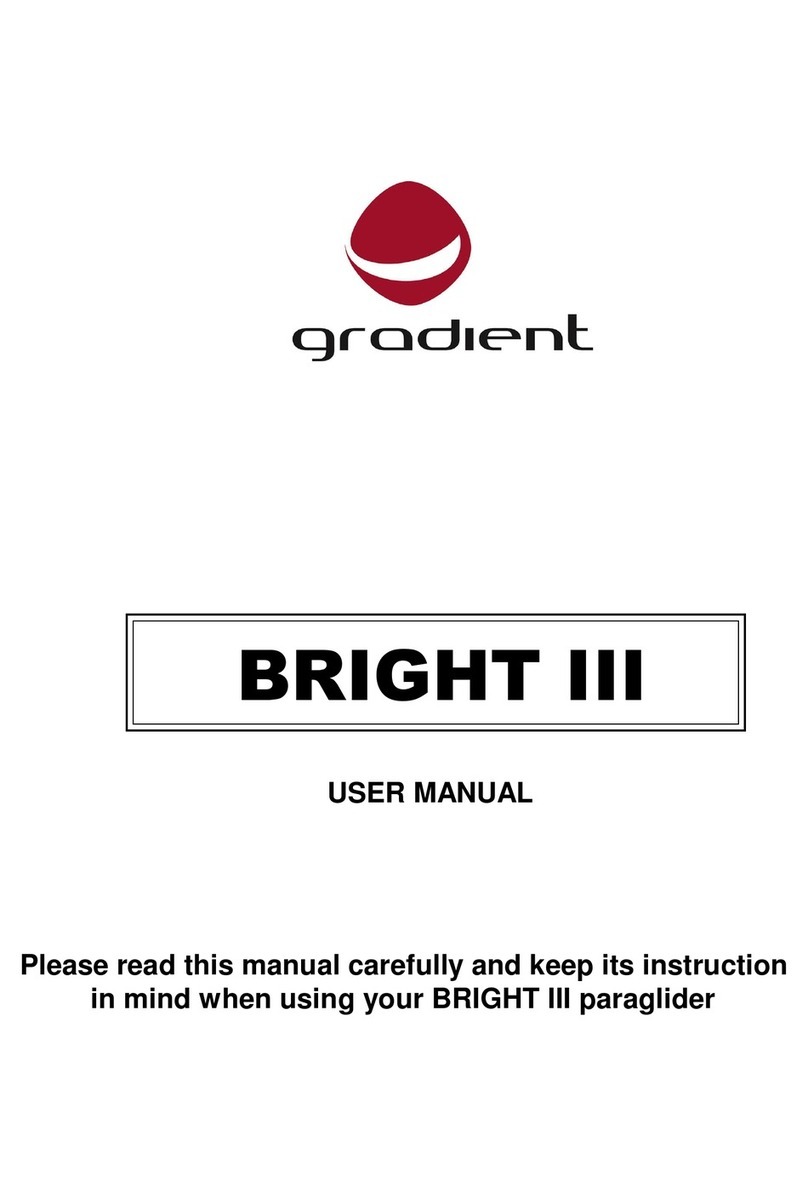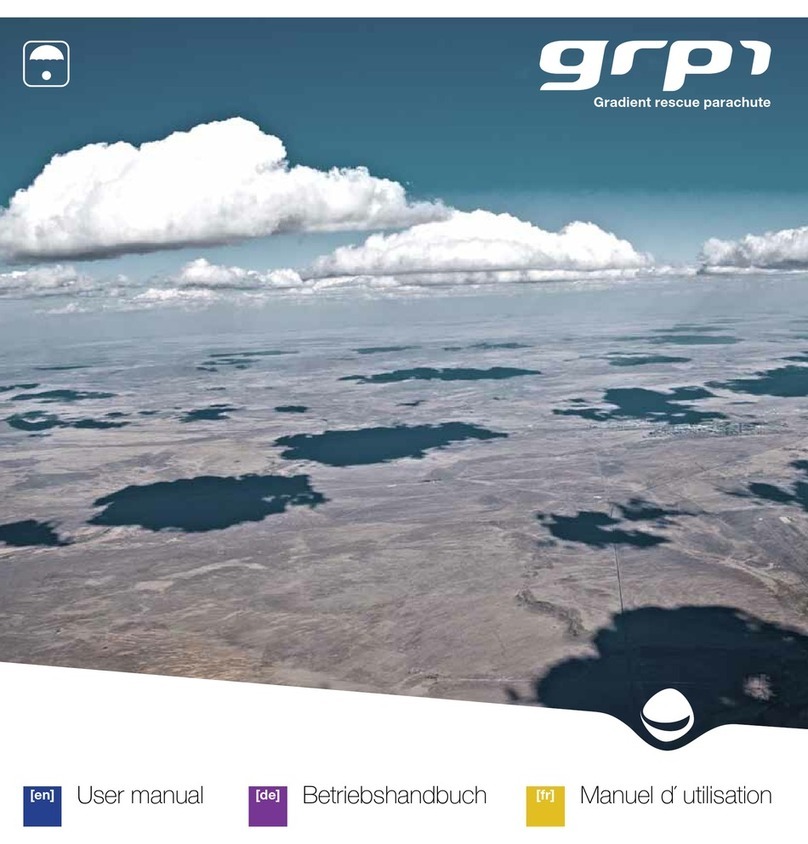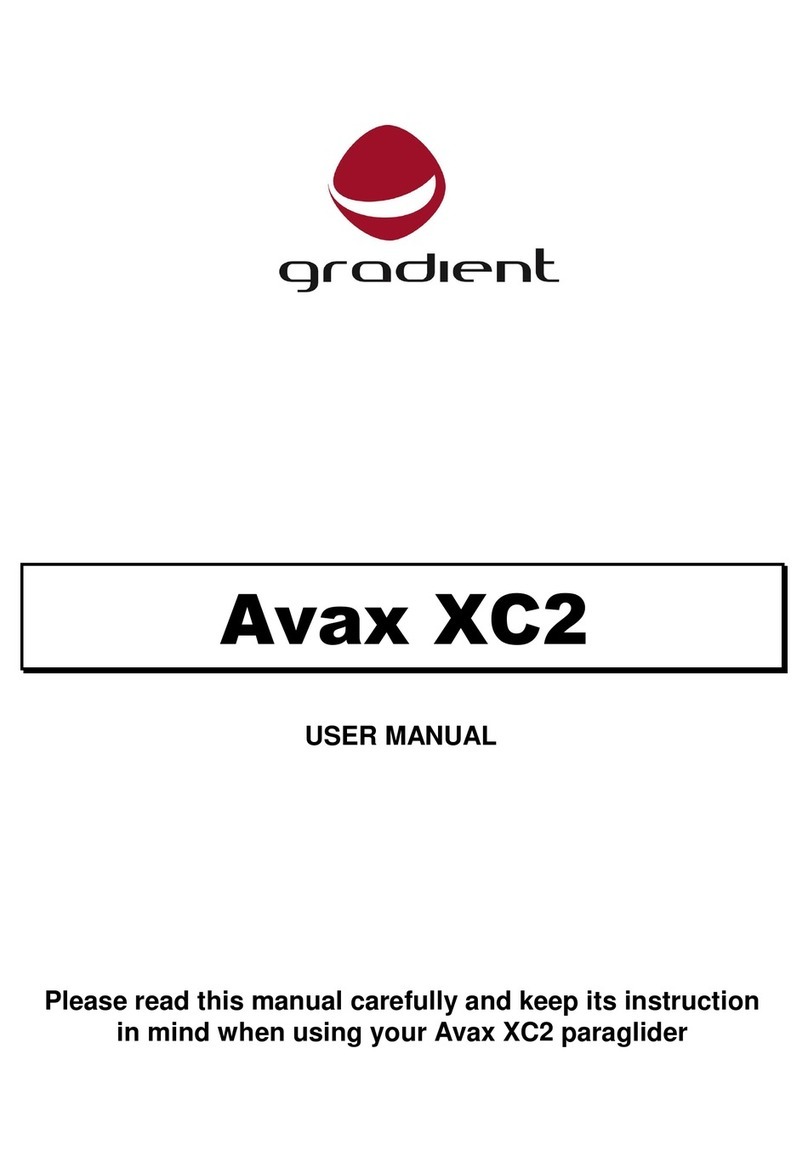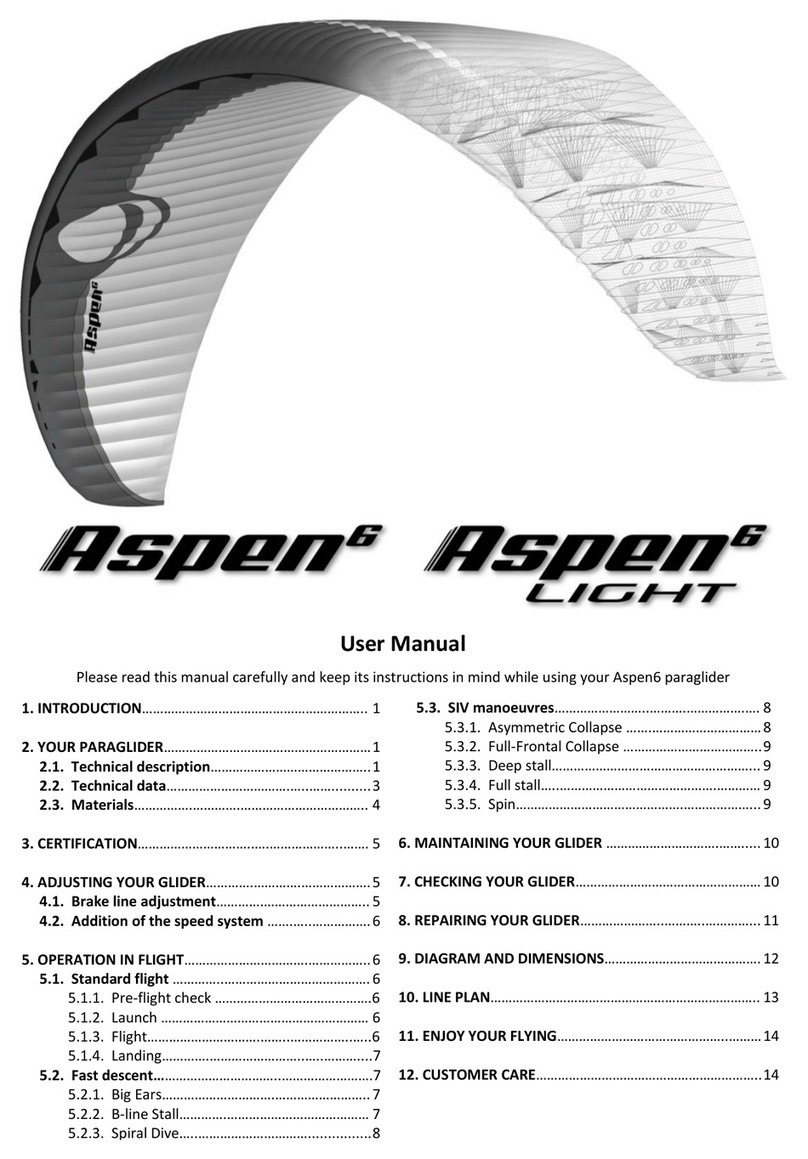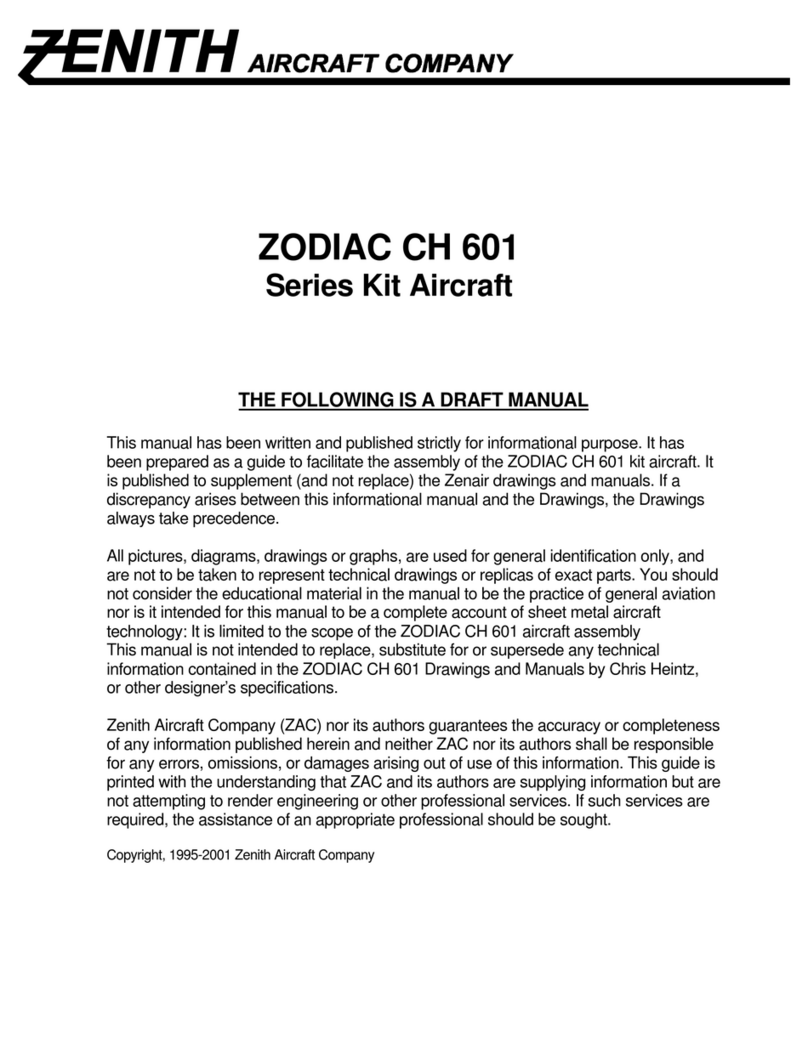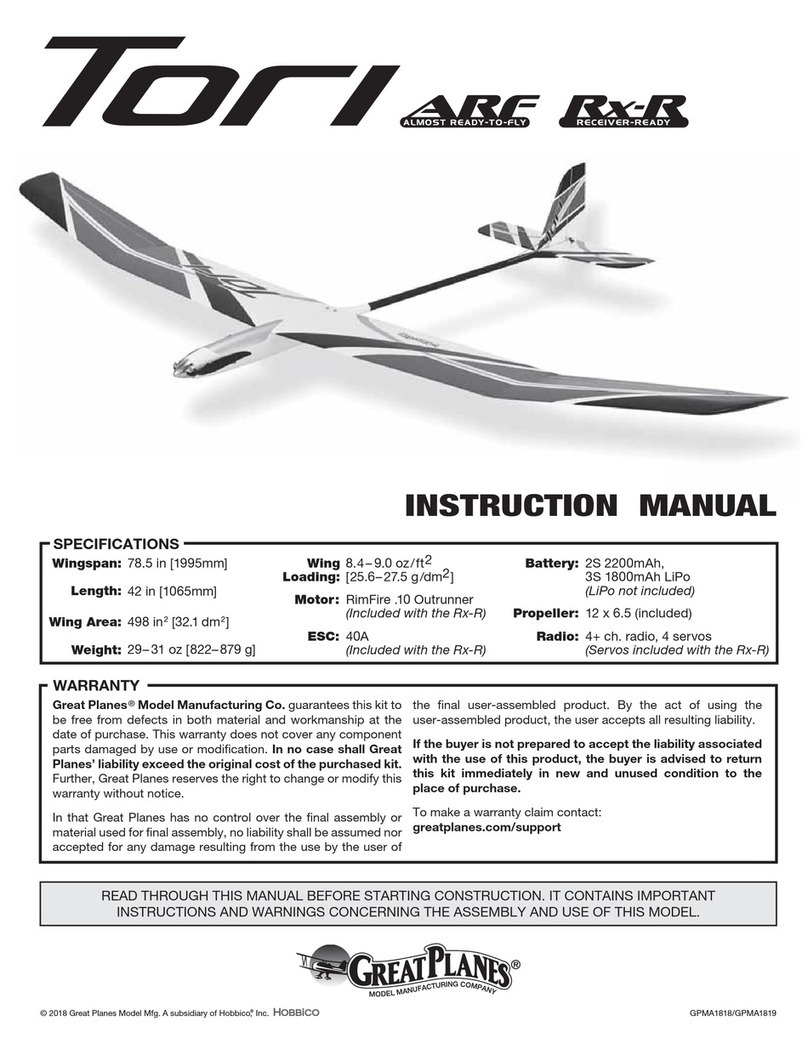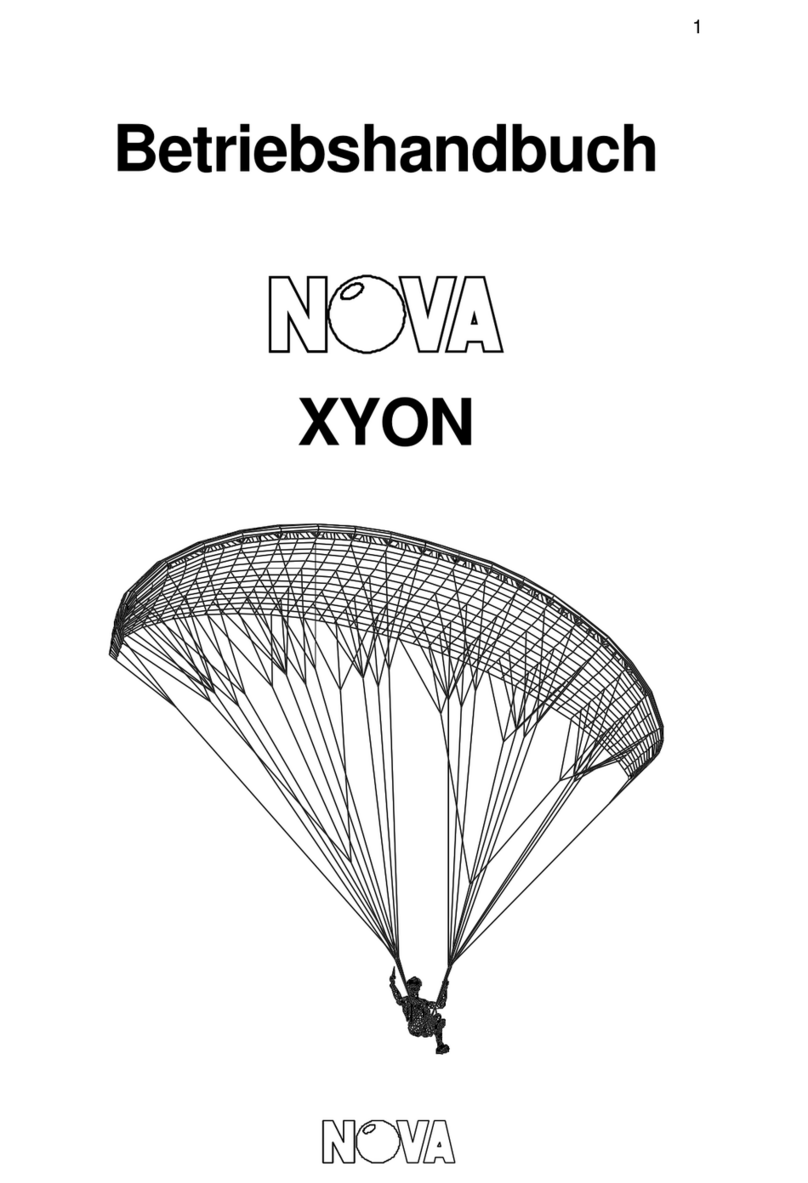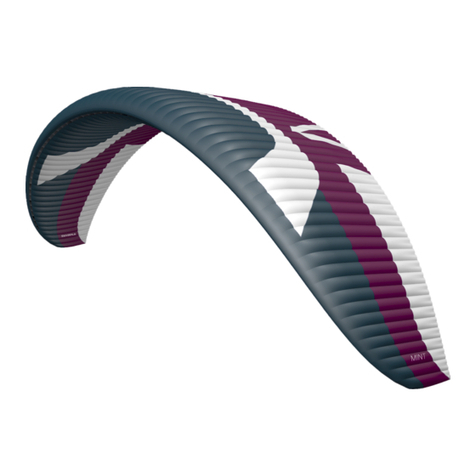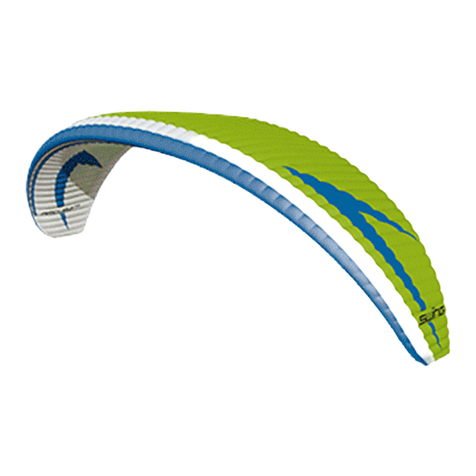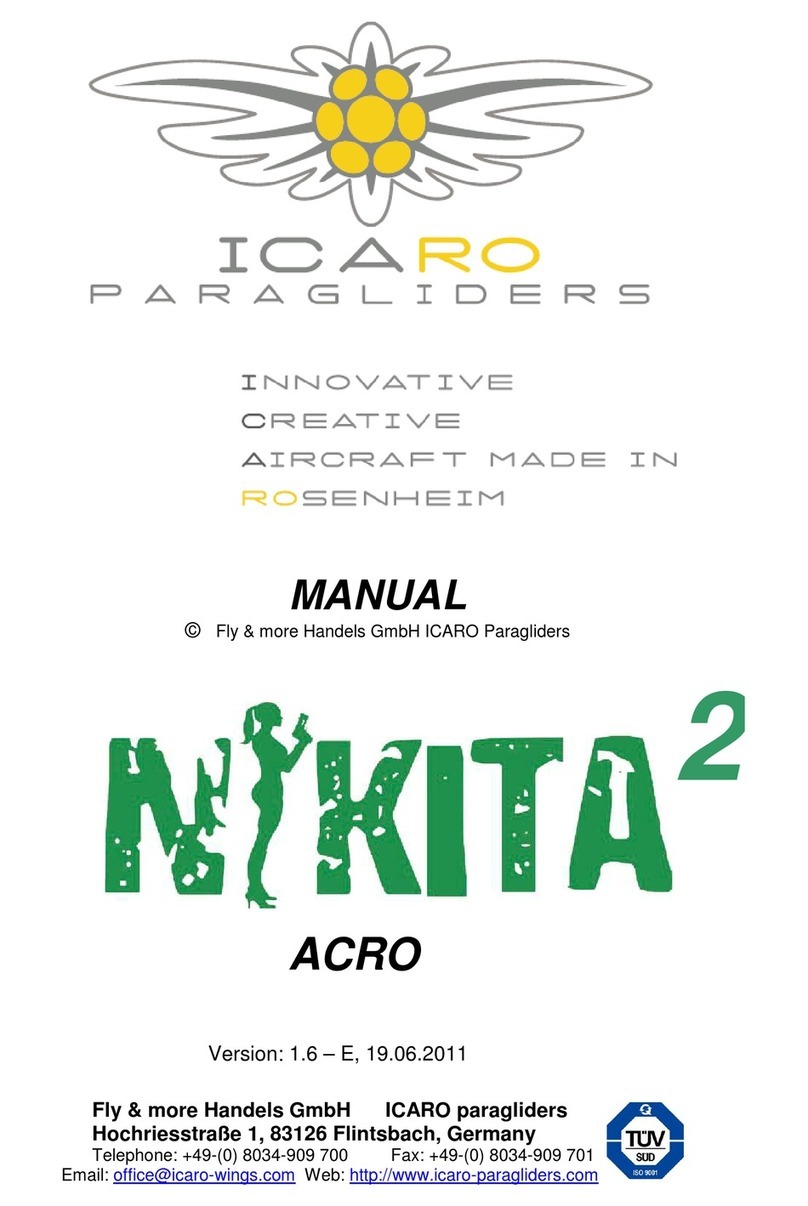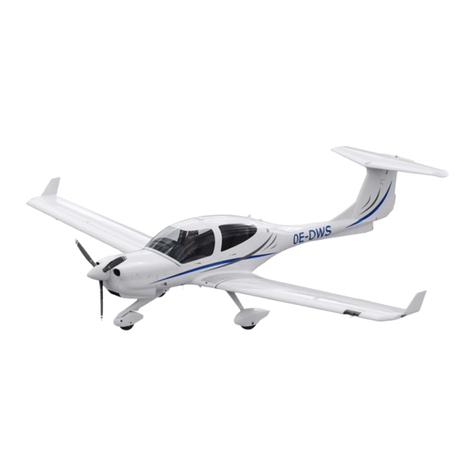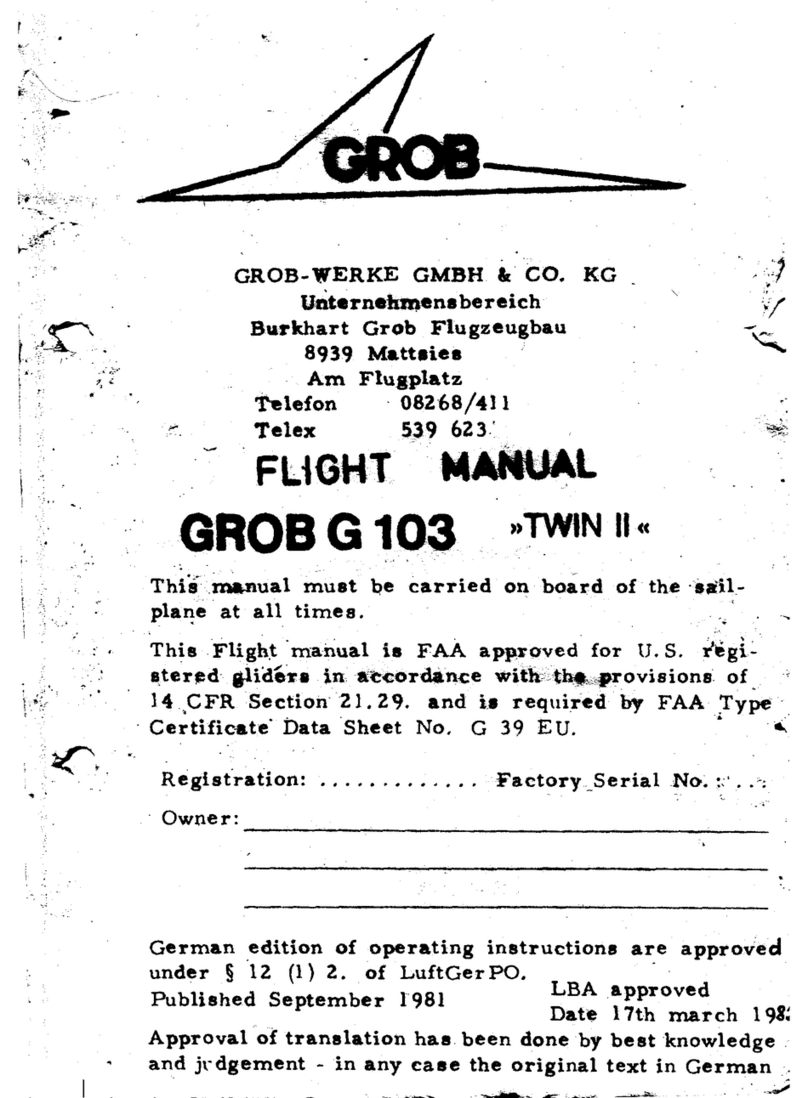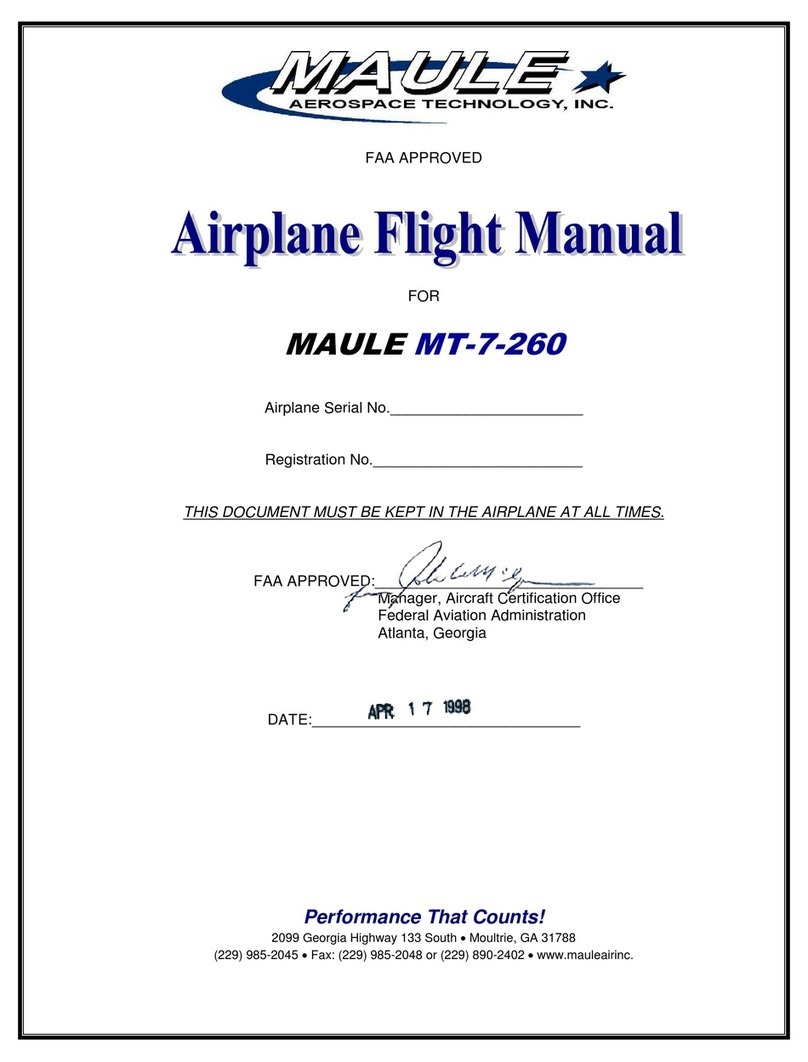Gradient bigoldern3 User manual

[en] - User manual, [de] - Betriebshandbuch, [fr] - Manuel d’ulisaon, [cz] - Uživatelská příručka

[en]
Gradient s.r.o., Plzenska 221/130, 150 00 Praha 5, tel+fax +420257216319, www.gradient.cx, gradient@gradient.cx.
User manual
Contens:
2.2. Technical data...............................................2
4.1. Brake-line lengths..........................................4
5.1.2. Launch.........................................................5
5.1.3.Flight............................................................5
5.1.4. Landing.......................................................6
5.2. Fast descent...................................................6
5.2.1. Big ears.......................................................6
5.2.2. B-line stall...................................................6
5.2.3. Spiral dive...................................................6
5.3. SIV maneuvers................................................7
5.3.1. Asymmetric collapse...................................7
5.3.2. Frontal collapse of the canopy...................7
6. Maintenance and storage................................8
7. Repairs...............................................................9
8. Conclusion.........................................................9
9. Line Map.........................................................11
using your BiGolden3 paraglider

1.
1. Introducon
Congratulaons on buying your new GRADIENT BiGolden3! We believe that you will be very
enthusiasc about its performance and ight characteriscs and we are sure you will be fully
sased with your new paraglider.
The BiGolden2 was introduced to the market at the start of 2009 and is sll one of the best
tandem gliders on the market. It took a rather long me to make a beer tandem glider than
the BiGolden2, but we are very happy we can say we have been successful!
The BiGolden3 is lighter, faster, more compact, has beer handling and more performance.
The canopy is designed from a well-proven combinaon of dierent materials: all Porcher
Skytex premium quality. Reinforcements are made with nylon rods, which helps for beer
inaon and a clean leading edge. Line drag is reduced by using well-proven DC Dyneema
lines. In combinaon with Edelrid Dyneema and aramid lines the result is an opmal balance
of strength, durability and drag.
We are sure the BiGolden3 is a beauful tandem glider with very nice handling; a truly
worthy successor to the BiGolden2.
The BiGolden3 is cered EN-B/LTF-B and is meant for a large group of pilots: from hobby
cross-country pilots to professional tandem pilots. Anyone in fact who wants exceponal
safety and easy take-o and landing characteriscs.
This manual will help you become familiar with your new paraglider and also provides
informaon that will allow you to get the best from your glider and keep it in good condion.
If you have any further quesons aer reading this booklet, please do not hesitate to contact
our company or any authorised dealer and we will gladly answer all your quesons.
When you have become familiar with your new BiGolden3 we would welcome any feedback
that you might have.
2. Descripon
2.1. Technical descripon
The BiGolden3’s improved prole means excellent aerodynamic eciency. Its characteriscs
give the maximum resistance to premature airow separaon and opmal control forces.
For beer distribuon of forces within the canopy, diagonal segmented rib technology is
used. These segmented ribs are anchored to the aachment points of the A, B and C lines
and distribute forces to the inner-ribs. This enables the canopy to be divided into as few as
thirteen carrying ribs on each side, while sll retaining the correct aerofoil shape. Thanks
to this, the BiGolden3 has fewer lines and therefore less drag. The result to the pilot of
this reduced drag is a higher top speed and beer glide angle. Diagonal segmented ribs
(compared to non-segmented diagonals) also increase compactness and canopy stability,
especially in terms of a glider’s capacity to recover from an asymmetric collapse.
A new form of “partly triangle cell openings” helps to inate the canopy across a wide range
of angle of aack. Graduated-sized cell-openings reduce the air movements and aid pressure
distribuon within the glider.
Five rows of lines (A, B, C, D, E) are used for the upper suspension system. Rows D and E
combine into main lines so a system of four risers can be used. This method helps to reduce
drag and gives maximum simplicity, which pilots will appreciate especially during the pre-
ight checks and on launch. The BiGolden3 is cered to be own with risers with trimmers.
Careful selecon of lines and materials means the wing-loading is opmised in ight in
any situaon. Progressive line diameters along the span and chord are already standard in
Gradient wings.

Gradient s.r.o., Plzenska 221/130, 150 00 Praha 5, tel+fax +420257216319, www.gradient.cx, gradient@gradient.cx.
A sophiscated combinaon of materials signicantly helps
to reduce weight of the glider (to 7.3 kg). The BiGolden3 is the
rst Gradient tandem glider where we have used Everlast,
a double-coated Porcher material. Everlast was developed
by Gradient in co-operaon with Porcher Sport, and this
exclusive material provides gliders with long-term stability
and durability.
The BiGolden3 is supplied with a well-tried four-riser speed
system with split A-risers and trimmers with a working
range of 8cm.
The total length of the risers is only 35cm.
Length of the BiGolden3 risers (mm):
Size 39-42 A1,A2 B C D
Basic posion 350 350 350 350
Slowed: 350 345 340 330
Accelerated: 350 360 375 410
2.2. Technical data
BiGolden 3 39 42
Flat Area [m2] 38.96 41.19
Projected area [m2] 33.40 35.32
Span [m] 14.44 14.84
Projected span [m] 11.62 11.96
Aspect rao 5.35 5.35
Projected aspect rao 4.04 4.05
Max. chord [m] 3.35 3.45
Min. chord [m] 0.705 0.725
Number of cells 57 57
Line consumpon [m] 449.7 462.4
Weight of the glider [kg] 6.9 7.3
Take-o weight range [kg] 120-190 140-220
Cercaon EN B EN B / LTF B
2.
A1
A2
B
C
D
basic posion

3.
2.3. Specicaons of materials
Canopy Fabric Finish Weight
Upper sail-leading edge Skytex 40 Everlast 40 g/m2
Upper sail-rear part Skytex 38 Universal 38 g/m2
Boom sail Skytex 32 Universal 32 g/m2
Ribs Skytex 40 Hard 40 g/m2
Non-carrying ribs Skytex 32 Hard 32 g/m2
Diagonals Skytex 40 / Skytex 32 Hard / Hard 40 g/m2 / 32 g/m2
Reinforcements Scrimm F02 420 X15A 180 g/m2
Reinforcements 060981450YET001 Scky laminate 60 g/m2
Reinforcements Hahl Nylon 6, 2/1200 Ø 2 mm
Lines Finish Diameter Strength Material
Liros DC 100 uncovered 0.7 mm 100 daN Dyneema
Liros DC 120 uncovered 0.8 mm 120 daN Dyneema
Cousin Vectran 16140 uncovered 0.7 mm 80 daN Vectran
Cousin Vectran
16330 uncovered 0.9 mm 100 daN Vectran
Edelrid 7850-100 covered 1.1 mm 100 daN Dyneema/PES
Edelrid 7850-130 covered 1.3 mm 130 daN Dyneema/PES
Edelrid 7850-160 covered 1.4 mm 160 daN Dyneema/PES
Edelrid 7850-200 covered 1.6 mm 200 daN Dyneema/PES
Edelrid 7343-190 covered 1.5 mm 190 daN Aramid/PES
Edelrid 7343-230 covered 1.8 mm 240 daN Aramid/PES
Edelrid 7343-280 covered 2.0 mm 280 daN Aramid/PES
Edelrid 7343-340 covered 2.1 mm 280 daN Aramid/PES
Edelrid 7343-420 covered 2.2 mm 280 daN Aramid/PES
Risers Fabric code Width Strength Material
Webbing 15 mm 850 daN PAD
Webbing 22 mm 1250 daN PAD
Pulleys Paray Al
Pulleys Rilay PAD
Karabiners Maillon Rapide Ø 3.5 mm 750 daN Steel

Gradient s.r.o., Plzenska 221/130, 150 00 Praha 5, tel+fax +420257216319, www.gradient.cx, gradient@gradient.cx.
4.
3. Cercaon
The BiGolden3 has passed European cercaon EN/LTF in category B in both sizes 39 and
42. The EN cercate of each BiGolden3 is found on the rib in the middle of canopy.
NOTICE: The BiGolden3 is constructed for hill or tow launches. Use of a subsidiary motor has
not been tested for by the manufacturer or by the Para-test!
This glider is not meant for jumping from a plane, balloon or for jumps with a delayed
opening of the canopy!
4. Adjusng your glider
Every BiGolden3, before it is given to a customer, goes through a nal check-up and test-
ight to verify that its characteriscs and measurements correspond to the manufacturer’s
specicaons. You may only make adjustments to the brake line lengths and only then in
keeping with the recommendaons of this manual.
Other adjustments or changes to your BiGolden3 lead to a loss of guarantee, airworthiness
and validity of the European cercaon. Amateur modicaon may endanger yourself and
other pilots. If you do have any suggesons for improvements let us know and our test-pilots
will try out your ideas without risk to yourself.
4.1. Brake line adjustment
The BiGolden3 risers have oponal posions for the
guide pulleys for the main control lines to suit each
pilot’s physical build, harness hangpoints, or style of
ying. As standard pulleys are placed on the upper
posion – see the picture – which ts most cases.
When you receive your new BiGolden3 the brake line-
length is adjusted to be the same as that used during
the tests. This length should suit most pilots and is
indicated on the main control line.
It is of course possible to adjust the brake
line length to suit each pilot’s preference.
We recommend that you act wisely when adjusng
brake line length and change the length in small
successive steps.
If you need to adjust brakes back to the basic posion
and the marks on the main brake lines are vague,
for the BiGolden3 42 use lengths 302 cm and for the
BiGolden3 39 use 294 cm.
Brake lines that are too short:
1) may lead to fague from ying with your hands in an unnatural posion,
2) will impede recovery from certain unstable maneuvers and
3) will certainly reduce your glider’s speed range.
Brakes that are too long will:
a) hamper pilot control during launch
b) reduce control in extreme ying situaons
c) make it dicult to execute a good are when landing.
Each brake line should be ed securely to its control handle. Only use knots that will
guarantee this, such as a Dragon’s Knot.
Posion Nr. 1
Posion Nr. 2

5.
5. Flight operaons
This manual is intended as a guide to the characterisc features of your new BiGolden3
paraglider. Under no circumstances should it be thought of as a “learn-to-y” manual for
paragliding, or as a substute for a paragliding pilots training course.
5.1 Standard ight regime
5.1.1 Pre-ight check
A thorough pre-ight check is essenal for safe ying and that’s why you should pay special
aenon to it. Above all you should check that the canopy, lines and risers are free from
damage and tangles. Also don’t forget about your harness and your reserve parachute.
Before the launch spread the canopy out into a slight arc and check that:
all cell openings are free
no lines are looped around or under the canopy
no lines are tangled or have a knot on them
any twigs, grass or other objects are not entangled in the lines or the canopy
risers are not twisted
control lines run freely through the pulleys
knots on control handles are secure
carabiners on risers are ghtened
trimmers on both sides are equally adjusted.
5.1.2 Launch
Launching the BiGolden3 is straighorward, either by front launch or by reverse launch.
A dynamic pull of the front risers (A-risers) will bring the canopy simply and easily above the
pilot’s head. The canopy inates from the centre equally and smoothly. The BiGolden3 has
no tendency to outrun the pilot and quickly stabilises above the pilot. Don’t forget to visually
check the canopy and its lines before launching.
Take o can be made easier by a light pull on the brakes.
The BiGolden3 requires no modicaon or parcular manoeuvre for launching by winch.
5.1.3 Flight
When the trimmers are adjusted to the Basic posion – where the boom edge of the
trimmer is at the boom edge of the main bandage – and brakes are loose, the BiGolden3 is
trimmed to y at best glide angle.
The best sink rate is produced with trimmers closed (pulled down) and both control lines
drawn down evenly to about 20%-25% of their range.
When the trimmers are fully open, the BiGolden3 is trimmed to y at max speed.
Flying in turbulent condions
When ying through severe turbulence it is recommended that the canopy is stabilised by
simultaneously applying a lile brake to both sides. Flying with a lile brake applied will also
help to prevent deaons and allow you to get more feedback from your glider. Responding
correctly to the paraglider’s movements by means of the brakes and weightshi is known as
“acve ying”. A pilot demonstrang good acve ying skills will signicantly reduce both
the number and severity of collapses he or she experiences.
Turning
The BiGolden3 is very comfortable and pleasant in turns. The handling characteriscs are
very responsive and accurate and demand no special habits or non-standard procedures.
When developing the BiGolden3 special aenon was devoted to the control forces
required to manoeuvre the paraglider. The result is that the brake travel and force has been

Gradient s.r.o., Plzenska 221/130, 150 00 Praha 5, tel+fax +420257216319, www.gradient.cx, gradient@gradient.cx.
6.
opmised. In ight the control forces are rm but responsive and precise and allow for
perfect communicaon with the canopy. Brake pressure is reassuringly progressive.
5.1.4 Landing
Landing with the BiGolden3 is very simple. On your rst ights you may be surprised at just
how well it glides. Take account of this when making your landing approach! Facing into
wind, at about one metre above the ground, pull down the brakes all the way. Under zero-
wind condions, or if forced to make an emergency landing downwind you may prefer to
take a wrap of each control line so as to enable a more dynamic are.
5.2. Rapid descent
Every pilot will sooner or later be in a posion when he/she has to quickly decrease his/her
altude. This situaon may come about as the result of a sudden and unexpected change in
the weather, reaching cloudbase and not wishing to enter cloud, or simply because you need
to nish your ight quickly. There are three main methods for achieving a rapid descent: Big
Ears, B-stall and Spiral dive.
5.2.1 Big Ears
This is the easiest technique for a rapid descent. Depending on how much of the wing p you
deate you will achieve 3 to 6m/s sink rate.
Iniaon: Take hold of the outer A-lines on both sides as high as possible and pull them down
uently and hold them rmly. The eecve area of the paraglider is reduced equally on both
sides of the wing. The size of the deated area depends on how deeply the lines are pulled
down. Be sure to pull both sides equally.
Recovery: Under normal circumstances the BiGolden3 opens automacally when the A-lines
are released. The opening may be accelerated by gently and repeatedly braking symmetrically
on both sides (slightly “pumping” the brakes).
5.2.2 B-line stall
B-line stall can be used on BiGolden3. This ight technique is a very eecve way of making
a rapid descent, but on account of the compactness of canopy and small lengths of risers,
it is not very simple. Depending on how much the B-risers are pulled down, the sink rate is
between 6m/s and 10m/s.
Iniaon: Take hold of the B-risers at the top and smoothly pull them down unl the canopy
shows a spanwise crease where the B-lines aach to the sail. Your sink rate will increase
considerably while your forward speed will decrease to praccally zero. Don’t be startled
when the airow over the top surface is detached and the canopy enters a parachutal stall
without moving forward. It will soon stabilise above your head.
Recovery: On releasing the B-risers the BiGolden3 automacally returns to normal ight
without staying in deepstall (sackug) or shoong in front of the pilot. Let go of the risers
smoothly and symmetrically.
Cauon: If the B-risers are released unevenly the canopy could enter a turn on release from
the B-stall. If the risers are released slowly and very unevenly it could start a spin.
5.2.3 Spiral dive
The spiral dive is the most eecve way of making a fast descent. Every pilot should be able
to perform a spiral dive and one day you may need to. Always be aware of your altude,
which decreases very rapidly during a spiral dive. The sink rate reached in a spiral dive anbe
more than 20m/s!
Iniaon: Smoothly pull on one brake so that the glider goes from a normal 360-degree turn
into a steep turn and from there into a spiral dive. The transion into a spiral dive can be

7.
made easier by weight shiing to the inner side of the turn. Keep an eye on the tension of
the control line all the me – reduced tension signalises an overload of the glider and danger
of falling into a negave spin.
Recovery: The BiGolden3 recovers from a spiral automacally as soon as the brakes are
released. Release them smoothly and always nish a spiral dive with safe altude!
5.3 SIV maneuvers
No maer what category of canopy you y or what level of cercaon it has, in turbulence
or in strong thermals you may experience all kinds of collapses. The BiGolden3 behaves
comfortably in these situaons, indeed not only does the BiGolden3 deal with extreme ight
regimes automacally, but also oers an above-average degree of safety. Even so, you must
follow all safety rules when pracsing special ight operaons and always pay aenon to
your altude!
Before performing special ight regimes remember:
Pracse reserve deployment on the ground, in a simulator, so that reserve deployment is
automac and ecient.
Rapid altude loss and considerable rotaonal forces may develop during unstable
maneuvers. Take account of these factors in the context of reserve deployment
5.3.1. Asymmetric collapse
Iniaon: Take hold of the outer A-lines on one side and pull them down smoothly. The wing
p will collapse downward forming a characterisc ‘big ear’. The size of the ear depends on
the depth to which the lines are pulled as well as the number of lines pulled down. You can
stop any tendency to turn by applying the opposite brake and by weight shiing onto the
inated side of the canopy.
Recovery: Under normal condions the BiGolden3 will re-inate spontaneously when the
pulled lines are released. The inaon me and loss of altude can be reduced by suitable
acon of the pilot. To stop any tendency to turn o course pull the brake on the inated side
(be careful not to overreact and stall the inated side) and weightshi to that side. If the
collapse remains then reinate the collapsed side by ‘pumping’ the brake on the collapsed
side to quicken the inaon.
5.3.2. Frontal collapse
Iniaon: Take hold at the top of both A-risers and pull them down unl the leading edge
collapses.
Recovery: In normal condions the BiGolden3 recovers normal ight automacally as
soon as the front risers are released. Opening may be assisted by applying both brakes
simultaneously to pump out the deaon.
5.3.3. Deep stall (“sackug”)
Iniaon: Pull both brakes smoothly unl the sink rate increases markedly and the forward
speed reaches almost zero. The pull on the brakes should be controlled so that the canopy
stays inated and doesn’t fall back into a full stall.
Recovery: The BiGolden3 cannot stay in this regime of deep stall ight, so aer the brakes are
released the glider automacally returns to normal ight. If you need to, you may accelerate
the recovery of the glider by one of two methods: either pump both brakes deeply with a fast
release, or pull lightly on the A-risers.
Cauon: If you pull too sharply on the A-risers you may experience a front collapse.

Gradient s.r.o., Plzenska 221/130, 150 00 Praha 5, tel+fax +420257216319, www.gradient.cx, gradient@gradient.cx.
8.
5.3.4 Negave spin
Iniaon: Slow down by braking to nearly minimum speed. Then pull a brake on one side
all the way down while simultaneously releasing the brake on the other side. Because the
stalled side falls back, the canopy suers airow separaon over one half of the wing which
results in a spin and a rapid loss of altude.
Recovery: Under normal circumstances the BiGolden3 is capable of recovering from
a negave spin automacally when the brakes are released.
Cauon: In general when there is a very fast or a long-lasng rotaon and when the brakes
are released too quickly, the canopy may shoot in front of the pilot followed by a massive
asymmetrical collapse.
Warning: In all regimes where the air ow is separated there is always a rapid increase in sink
rate and therefore a substanal loss of altude.
And remember: A wrong manoeuvre at the wrong me may change a fairly easy situaon
into a dangerous problem. Furthermore you are exposing your glider to forces which may
damage it. So pracse your pilong abilies for these special ight regimes only under the
supervision of your instructor and with a reserve parachute.
6. Maintanence and storage
If you handle your glider with care and store it in a suitable place it can last you a very long
me. On the other hand neglecng maintenance, bad storage and the use of unsuitable
cleaning products can reduce the lifeme of your glider signicantly or may even make it
dangerous.
You must keep to these rules:
Choose a suitable area for your launches. Lines caught on roots or rocks lead to unnecessary
strains on the aachment tabs during inaon. Snagging lines may rip the canopy ssue or
damage lines.
When landing, never let the canopy fall on its leading edge in front of the pilot. The eect
of these forceful collisions and the sudden pressure increase can severely damage the air
resistant coang of the canopy as well as weakening the ribs and seams.
Protect the canopy from unnecessary strain. Inconsiderate handling of your glider, namely
pulling it over grass, soil, sand or even over rocks, will signicantly reduce its lifeme and
increase its air-porosity.
When preparing the paraglider for a launch or when ground handling, be sure not to step on
any of the lines or the canopy.
Don’t e any unnecessary knots in the lines. A packing method where special knots are made
in the lines as used on parachutes and reserve parachutes aren’t suitable for packing the
lines used on paragliders.
Protect your canopy and lines from unnecessary exposure to sunlight. UV-rays can damage
many parts of a paraglider.
Try not to pack your glider when wet. If there’s no other way then dry it as soon as possible
but away from direct sunlight.
Don’t let your glider come into contact with sea water. If it does, rinse (the lines, canopy and
risers) with fresh water and dry before storing.
Aer ight or when storing, always use the inner protecon sack.
When storing or during transport make sure your glider isn’t exposed to temperatures higher
than 50 degrees Celsius.

9.
Never let the glider come into contact with chemicals. Clean the paraglider with clean
lukewarm water only.
For long-term storage don’t pack the glider too ghtly and store it in a cold, dry and well-
venlated room.
Aer tree- or water landings always examine the glider carefully. If you suspect that the ight
features of your paraglider have changed, contact the nearest authorised GRADIENT supplier
as soon as possible.
Aer 200 ying hours or aer two years at the latest your BiGolden3 must be thoroughly
checked and tested by the manufacturer or an authorised Gradient service centre.
7. Repairs
Only small repairs may be done by the user, which means repairs that don’t change the
airworthiness of the paraglider. Among these are xing small tears (besides seams) up to
10cm, changing damaged lines or the change of rubber line-xaon-rings on the small
carabiners.
When repairing your paraglider on your own keep the following rules:
When repairing the sail use the self-adhesive patches specied for this purpose.
Every BiGolden3 comes with a repair kit.
The only admissible repairs done on lines are those where the damaged lines are changed
for new ones exclusively supplied by the manufacturer of BiGolden3, authorised dealer
or service. When ordering new lines use code indicators given in the aached diagram of
suspension lines. Also give the indicator “BiG3” (BiGolden3) and the size of the canopy of
your glider, i.e.
BiG2 42, followed by the line code; for example:
- The outside long line in line A for BiGolden3 42: BiG3 42 A 1.3
An excepon is changing a control line while out ying. For this purpose the manufacturer
encloses a spare line with every BiGolden3 with a prepared loop on one end. The right length
should be adjusted according to the same line on the opposite side of the canopy and then
aach your brake handle. As soon as you can, swap the line for an original one from your
authorised GRADIENT service centre.
Aer any changing of lines a thorough pre-ight check must be done. Don’t hesitate to ask
your instructor or an experienced colleague for help. If you’re not sure, entrust the job to
either the manufacturer or an authorised GRADIENT dealer.
If you have to replace any of the line-dy rings (a spare ring is supplied with each BiGolden3).
Don’t forget to check that the lines haven’t been swapped accidentally and that they are
returned to the small karabiner in the correct order.
8. Conclusion
Even though the BiGolden3 has outstanding performance and stability, it must be understood
that even the safest paraglider is an aircra and that all air-sports can be relavely dangerous.
Remember that not only your safety but your passenger’s too lies in your hands.
Never underesmate weather condions and never forget that you are ying for pleasure
and not to become a ‘fallen hero’. Remember this and the fun that only free-ying can bring
will be yours.
We believe that your sensible atude and the ight characteriscs of your
BiGolden3 will combine to ensure you fantasc ying.

Gradient s.r.o., Plzenska 221/130, 150 00 Praha 5, tel+fax +420257216319, www.gradient.cx, gradient@gradient.cx.
10.
GRADIENT wishes you many fabulous ights and happy landings.
Ondřej Dupal Václav Sýkora
Director Designer

11.
Row A
Row B
Row C
Row D
Brakes R
10. Gradient BiGolden3 – Line Map
Middle of the cannopy
1.1 1.2 1.3
2.1 2.3 2.52.2 2.4 2.6
3.1 3.5 3.93.2 3.6 3.103.3 3.7 3.113.4 3.8 3.12 3.13
1.1 1.2 1.3
2.1 2.3 2.52.2 2.4 2.6
3.1 3.5 3.93.2 3.6 3.103.3 3.7 3.113.4 3.8 3.12 3.13
1.1 1.2 1.3
2.1 2.3 2.52.2 2.4 2.6
3.1 3.5 3.93.2 3.6 3.103.3 3.7 3.113.4 3.8 3.12 3.13
S1
S2 S3
S7 S8 S9
S5
S10
S6
1.1 1.2
2.1 2.3 2.52.2 2.4
2.6
3.1 3.6 3.93.2 3.6 3.103.3 3.7
4.11
3.4 3.8
4.12
S
4.13
4.1D:
4.1E:
4.5
4.5
4.9
4.9
4.2
4.2
4.6
4.6
4.10
4.10
4.3
4.3
4.7
4.7
4.4
4.4
4.8
4.8
S4
1.1 1.2
2.1 2.2 2.3 2.4 2.5 2.6
3.1 3.2 3.6
0
3.5 3.8 3.9 3.10 3.11 3.12 3.133.73.43.3

Table of contents
Other Gradient Aircraft manuals
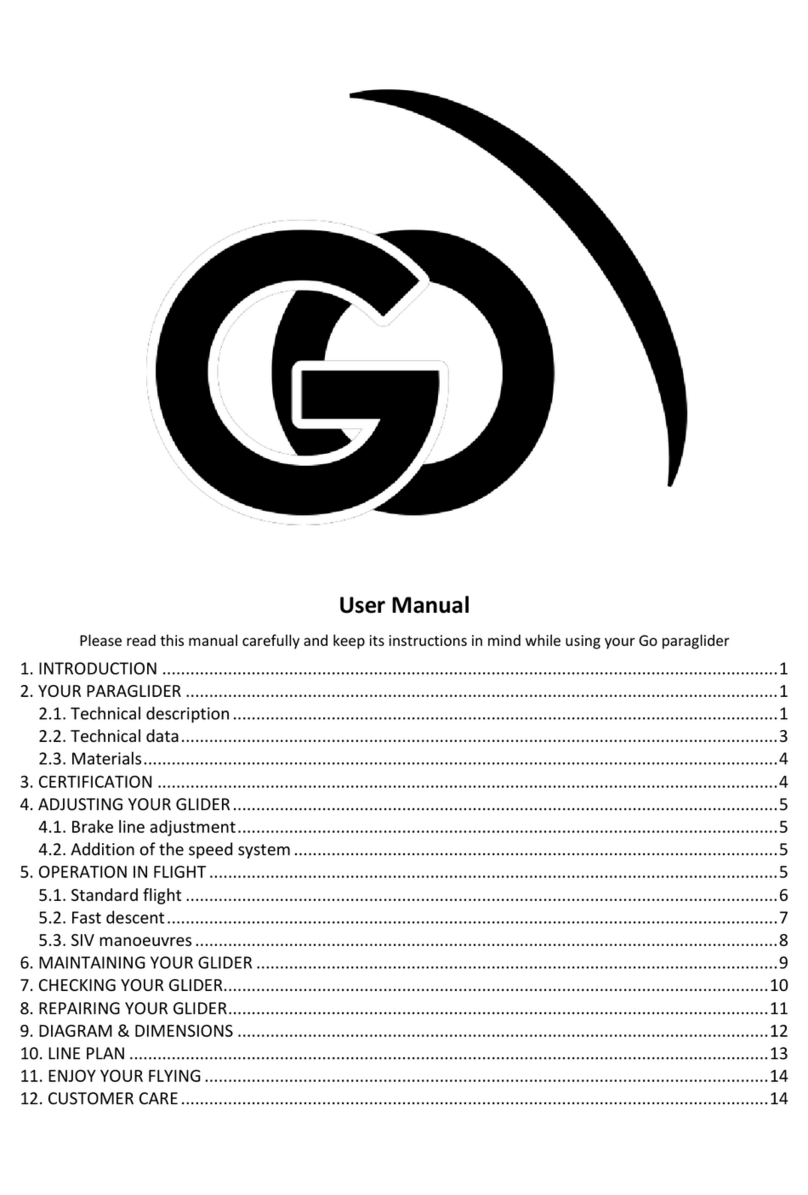
Gradient
Gradient GO Series User manual
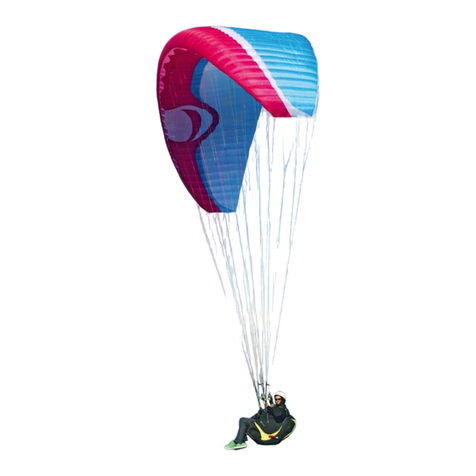
Gradient
Gradient Golden4 User manual
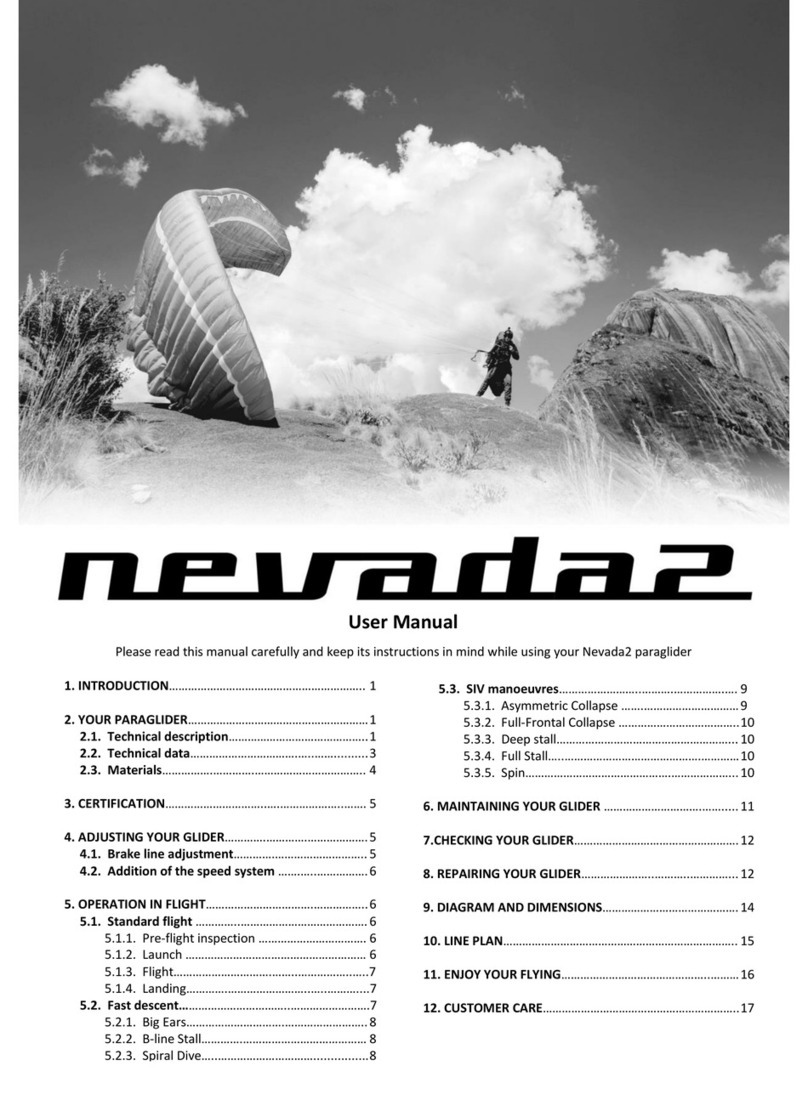
Gradient
Gradient Nevada2 User manual

Gradient
Gradient FREESTYLE 2 User manual
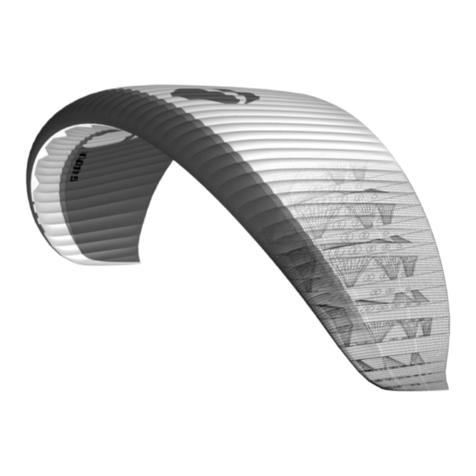
Gradient
Gradient Montana 3 User manual

Gradient
Gradient Golden5 User manual
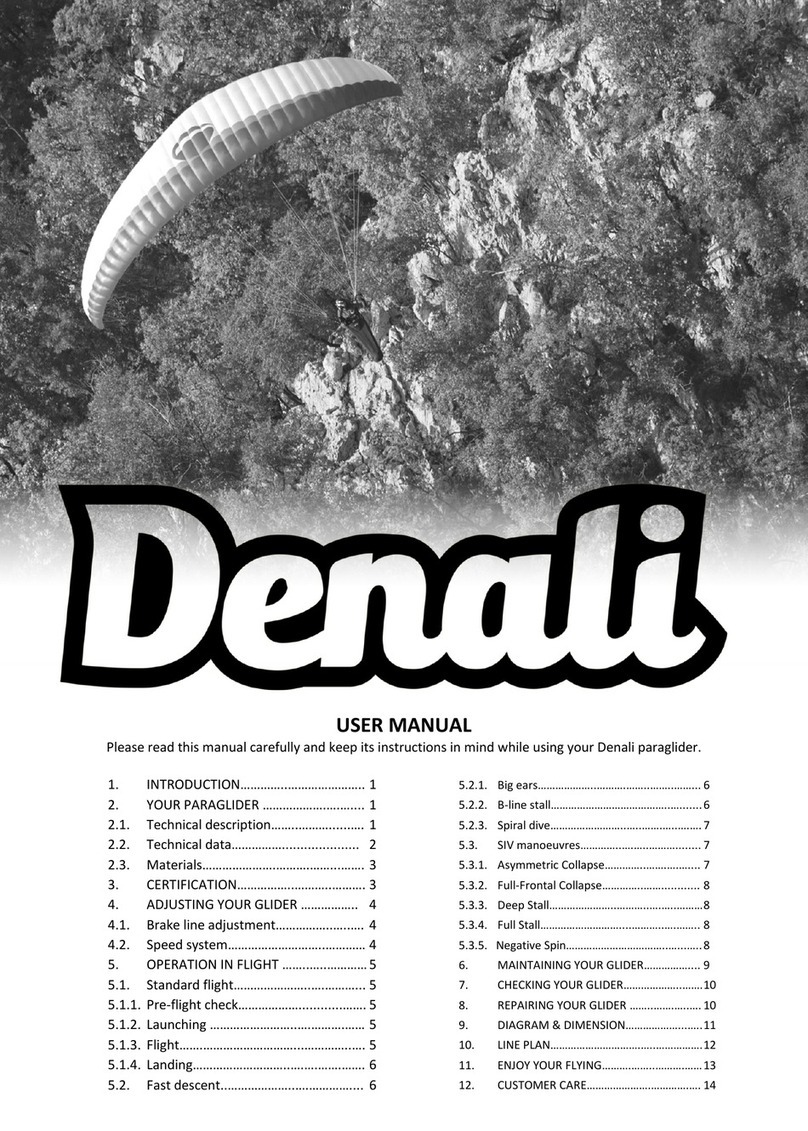
Gradient
Gradient Denali User manual
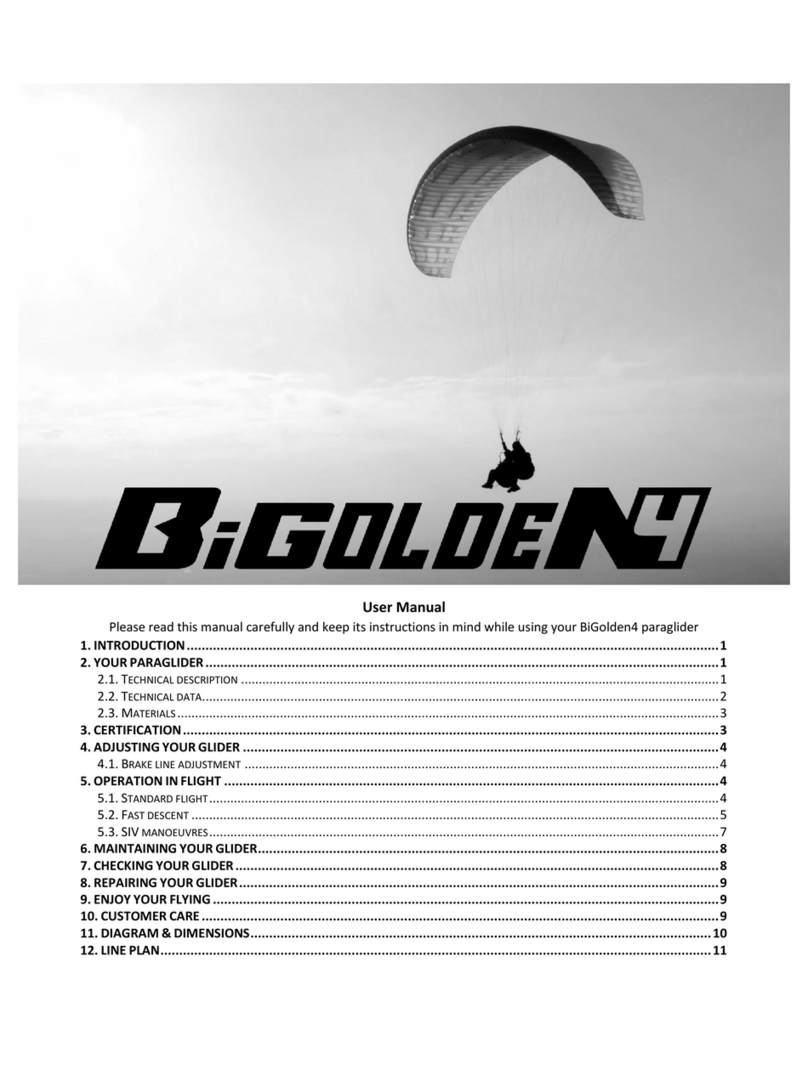
Gradient
Gradient BiGolden4 User manual
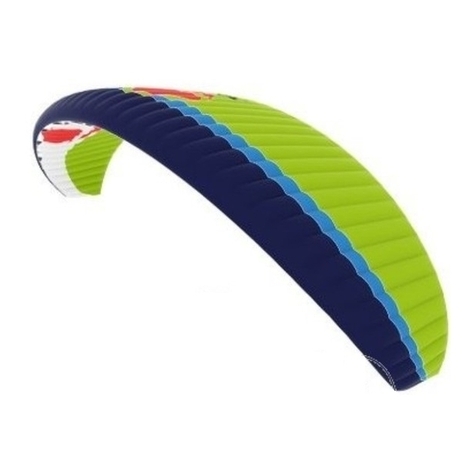
Gradient
Gradient Aspen5 User manual
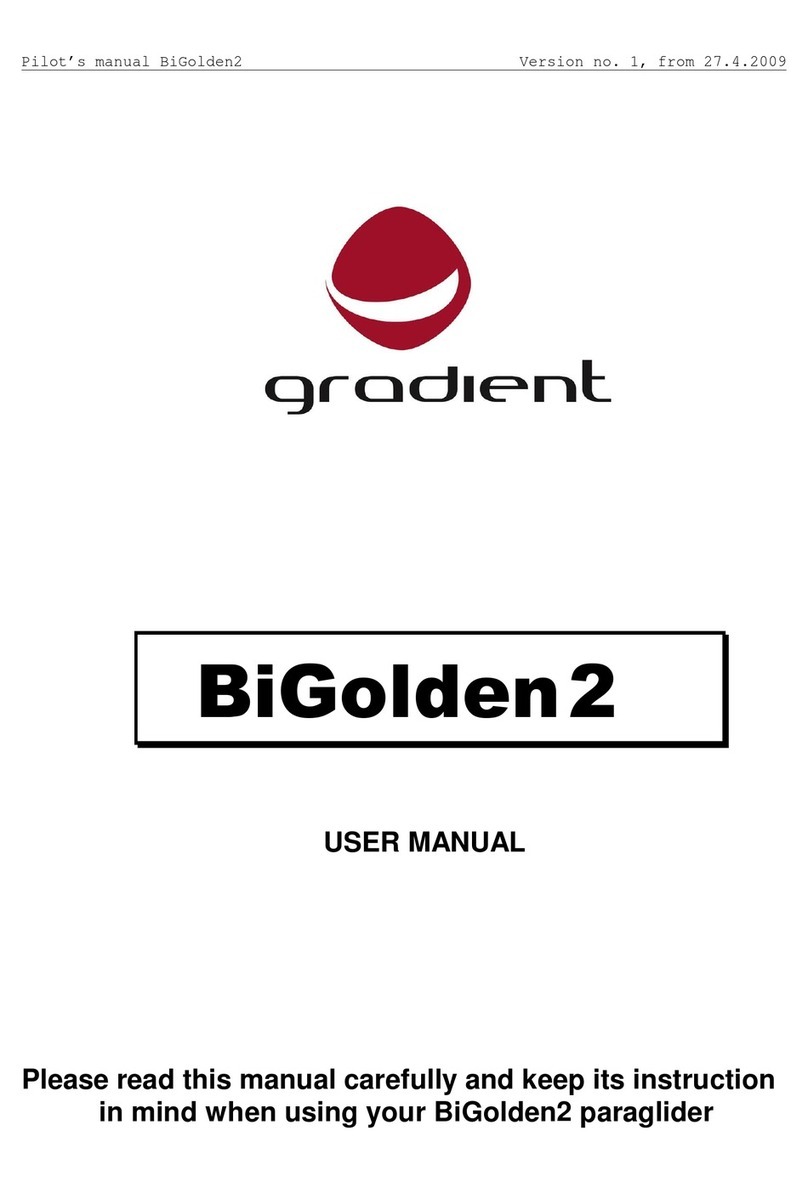
Gradient
Gradient BiGolden2 38 User manual
